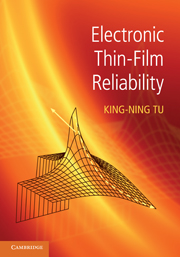Book contents
- Frontmatter
- Dedication
- Contents
- Preface
- 1 Thin-film applications to microelectronic technology
- 2 Thin-film deposition
- 3 Surface energies
- 4 Atomic diffusion in solids
- 5 Applications of the diffusion equation
- 6 Elastic stress and strain in thin films
- 7 Surface kinetic processes on thin films
- 8 Interdiffusion and reaction in thin films
- 9 Grain-boundary diffusion
- 10 Irreversible processes in interconnect and packaging technology
- 11 Electromigration in metals
- 12 Electromigration-induced failure in Al and Cu interconnects
- 13 Thermomigration
- 14 Stress migration in thin films
- 15 Reliability science and analysis
- Appendix A A brief review of thermodynamic functions
- Appendix B Defect concentration in solids
- Appendix C Derivation of Huntington's electron wind force
- Appendix D Elastic constants tables and conversions
- Appendix E Terrace size distribution in Si MBE
- Appendix F Interdiffusion coefficient
- Appendix G Tables of physical properties
- Index
- References
5 - Applications of the diffusion equation
Published online by Cambridge University Press: 05 July 2014
- Frontmatter
- Dedication
- Contents
- Preface
- 1 Thin-film applications to microelectronic technology
- 2 Thin-film deposition
- 3 Surface energies
- 4 Atomic diffusion in solids
- 5 Applications of the diffusion equation
- 6 Elastic stress and strain in thin films
- 7 Surface kinetic processes on thin films
- 8 Interdiffusion and reaction in thin films
- 9 Grain-boundary diffusion
- 10 Irreversible processes in interconnect and packaging technology
- 11 Electromigration in metals
- 12 Electromigration-induced failure in Al and Cu interconnects
- 13 Thermomigration
- 14 Stress migration in thin films
- 15 Reliability science and analysis
- Appendix A A brief review of thermodynamic functions
- Appendix B Defect concentration in solids
- Appendix C Derivation of Huntington's electron wind force
- Appendix D Elastic constants tables and conversions
- Appendix E Terrace size distribution in Si MBE
- Appendix F Interdiffusion coefficient
- Appendix G Tables of physical properties
- Index
- References
Summary
Introduction
When the initial and boundary conditions are given, many solutions of the diffusion equation have been obtained in the literature and textbooks, and the solutions have been applied to many technical problems [1–6]. In this chapter, we shall select a few thin-film problems to illustrate the application of Fick's first and second laws.
Darken's analysis of the Kirkendall effect of interdiffusion in a bulk diffusion couple will be presented [3–5]. Why do we include the bulk diffusion behavior in a book on thin-film reliability? This is because interdiffusion is one of the most common behaviors in materials, whether it is in bulk or in thin films. More importantly, it will help us to understand the mechanism of failure in thin films. In Darken's analysis of interdiffsuion, specifically, no void formation and no stress are assumed, hence there is no failure in the microstructure. It is a constant volume kinetic process. While Darken's analysis explains the Kirkendall shift (or lattice shift) by assuming vacancy to be equilibrium everywhere in the sample, it does not allow Kirkendall (or Frenkel) void formation. Only when vacancies are supersaturated will voids nucleate and form. Thus, Kirkendall (or Frenkel) void formation will require a different condition from that in Kirkendall shift, so we assume that Kirkendall shift is missing in void formation.
- Type
- Chapter
- Information
- Electronic Thin-Film Reliability , pp. 86 - 117Publisher: Cambridge University PressPrint publication year: 2010



